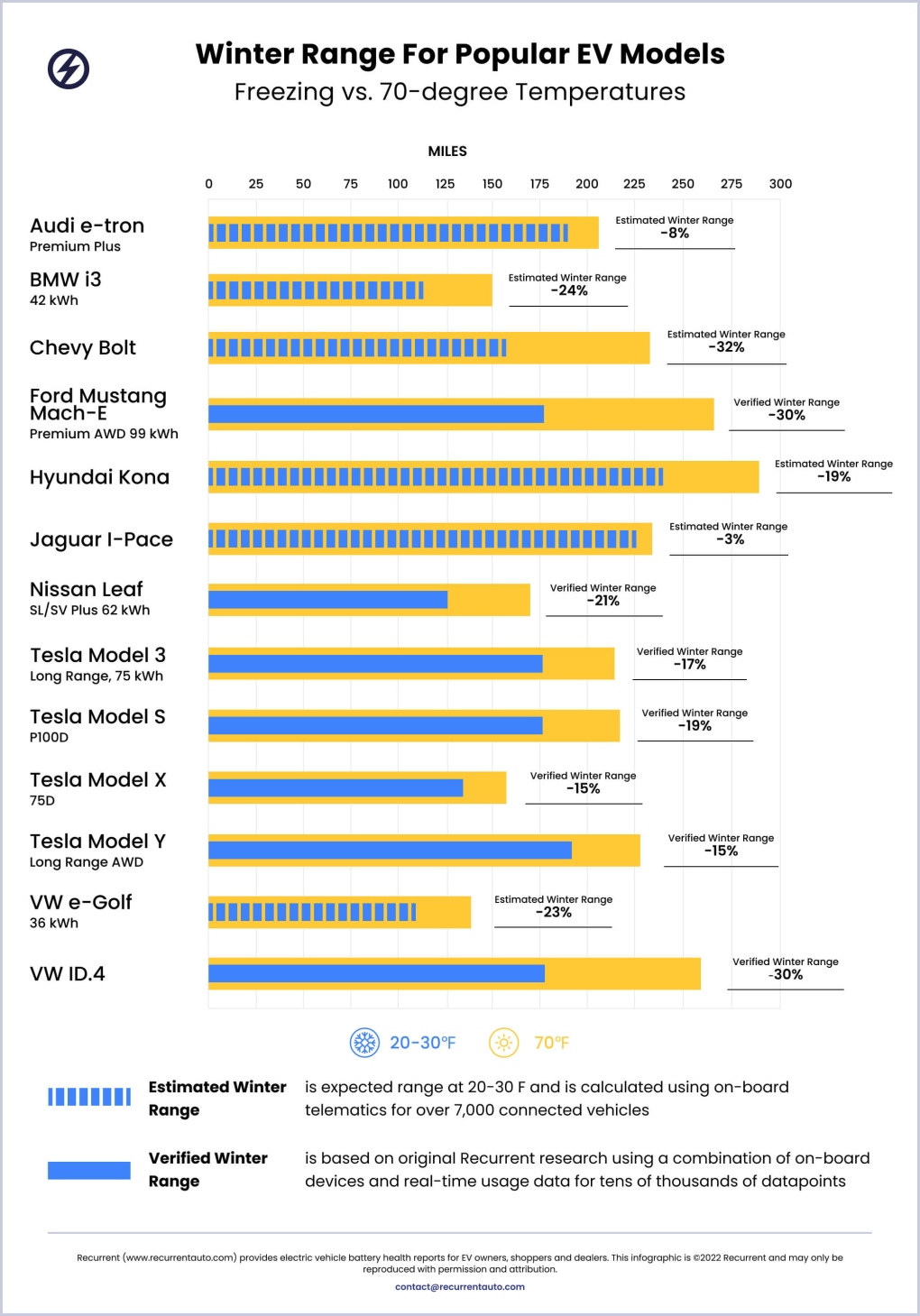Dec. 23, 2022, Toronto: Electronics, including cell phones, digital cameras and laptops, lose some of their power in cold temperatures, and the same can be said for electric vehicles (EVs). According to RecurrentAuto.com, some EVs can lose up to 160 kilometres or 35 percent of their range in cold temperatures.
Canada moves to mandate electric vehicle sales starting in 2026. Recurrent’s battery scientist Jon Witt said this happens for a few reasons, one factor is the physical and chemical reactions in the battery slow down in cold temperatures, reducing an EV’s power.
The other factor is that EVs need to work harder than those with internal combustion engines to heat themselves. Internal combustion engines produce a lot of extra heat wasted in the summer but can be re-directed to warm the cabin in the winter. EV motors are more efficient, and the slight heat generated by the motor is used to warm the battery. Cabin heating, in turn, relies on power drawn from the battery, which further reduces the battery’s charge.
On the flip side, lithium-ion batteries, like those used in most EVs, work so well in warm temperatures that they degrade more quickly. Temperature affects the rate of chemical reactions inside a battery, so the higher the temperature, the faster the responses, the more energy produced, and the faster the degradation.
Not many Canadians need to worry about those warmer climes, with bitterly cold temperatures forecast across the country this week. However, it could be helpful to know how to get the most out of an EV’s battery for the future since Environment Minister Steven Guilbeault proposed new regulations on Wednesday that would make it mandatory for one-fifth of all passenger cars, SUVs and trucks sold in Canada in 2026 to run on electricity.

By 2030, that proportion will rise to 60 percent of all sales. By 2035, every passenger vehicle sold in Canada will need electricity. The mandate’s purpose is to ensure Canadians have better access to electric vehicles, Guilbeault’s parliamentary secretary Julie Dabrusin said during Wednesday’s announcement.
The graphic below and information about how some of the most popular EV models perform in cold weather compared to the manufacturers’ listed range were provided by Recurrent. The full report can be found here.
Disclaimer: Numbers in the graphic will differ from the data below because, while the graphic shows the cold-weather range loss for each vehicle as a percentage of the range at 70 F (21 C), the reporting below lists the cold-weather range as a percentage of the manufacturer’s listed range.
Audi e-Tron winter range
Model or trim: Premium Plus
Observed range at -6.67 to -1 C: 93 percent of the original range
Observed range at 21C: 101 percent of the original range
BMW i3 winter range
Model or trim: 42 kWh battery
Observed range at -6.7 to -1 C: 74 percent of the original range
Observed range at 21C: 98 percent of the original range
Chevy Bolt winter range
Model or trim: 60 kWh battery
Observed range at -6.7 to -1 C: 66 percent of the original range
Observed range at 21C: 98 percent of the original range
Chevy Volt winter range
Model or trim: 18.4 kWh battery
Observed range at -6.7 to -1 C: 69 percent of the original range
Observed range at 21C: 100 percent of the original range
Ford Mustang Mach-E winter range
Model or trim: Premium AWD
Verified range at -6.7 to -1 C: 65 percent of the original range
Observed range at 21C: 95 percent of the original range
Hyundai Kona Electric winter range
Observed range at -6.7 to -1 C: 93 percent of the original range
Observed range at 21C: 112 percent of the original range
Jaguar I-PACE winter range
Observed range at -6.7 to -1 C: 97 percent of the original range
Observed range at 21C: 100 percent of the original range
Nissan LEAF winter range
Model or trim: SL/SV Plus 62 kWh battery
Observed range at -6.7 to -1 C: 54 percent of the original range
Observed range at 21C: 75 percent of the original range
Tesla Model 3 winter range
Model or trim: Long range
Observed range at -6.7 to -1 C: 44 percent of the original range
Observed range at 21C: 62 percent of the original range
Tesla Model Y winter range
Model or trim: Long-range AWD
Observed range at -6.7 to -1 C: 49 percent of the original range
Observed range at 21C: 64 percent of the original range
Tesla Model S winter range
Model or trim: 75D
Observed range at -6.7 to -1 C: 45 percent of the original range
Observed range at 21C: 63 percent of the original range
Tesla Model X winter range
Model or trim: 75D
Observed range at -6.7 to -1 C: 48 percent of the original range
Observed range at 21C: 61 percent of the original range
VW e-Golf winter range
Model or trim: 36 kWh battery
Observed range at -6.7 to -1 C: 88 percent of the original range
Observed range at 21C: 111 percent of the original range
VW ID.4 winter range
Model or trim: 82 kWh battery
Observed range at -6.7 to -1 C: 65 percent of original range
Observed range at 21C: 95 percent of original range
Source: CTV; With files from The Canadian Press







